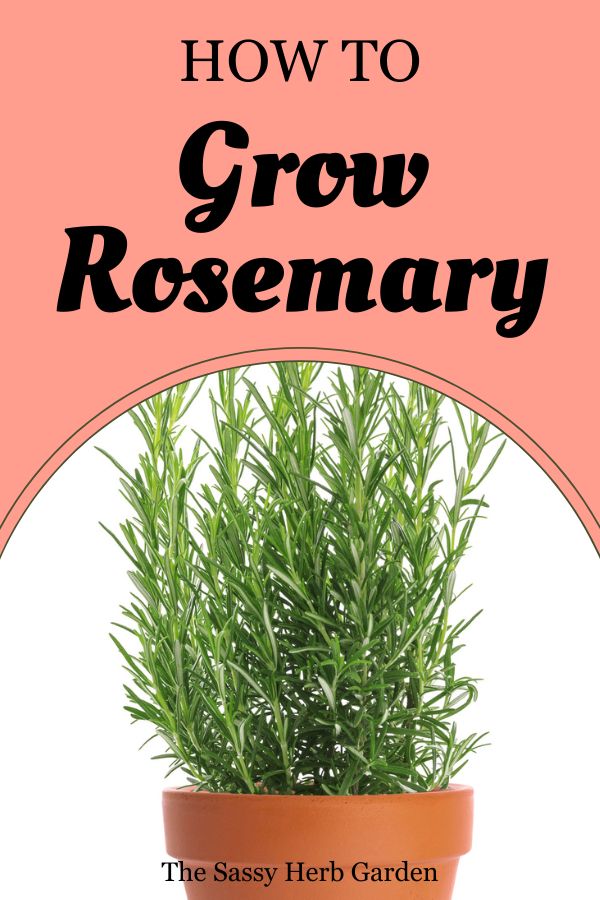Rosemary is a moderately easy herb to grow. With a small effort, you can enjoy this fragrant herb, adding beauty and flavor to your garden and kitchen. In this guide on how to grow rosemary, we share a few secrets to help you successfully plant, grow, and care for rosemary.
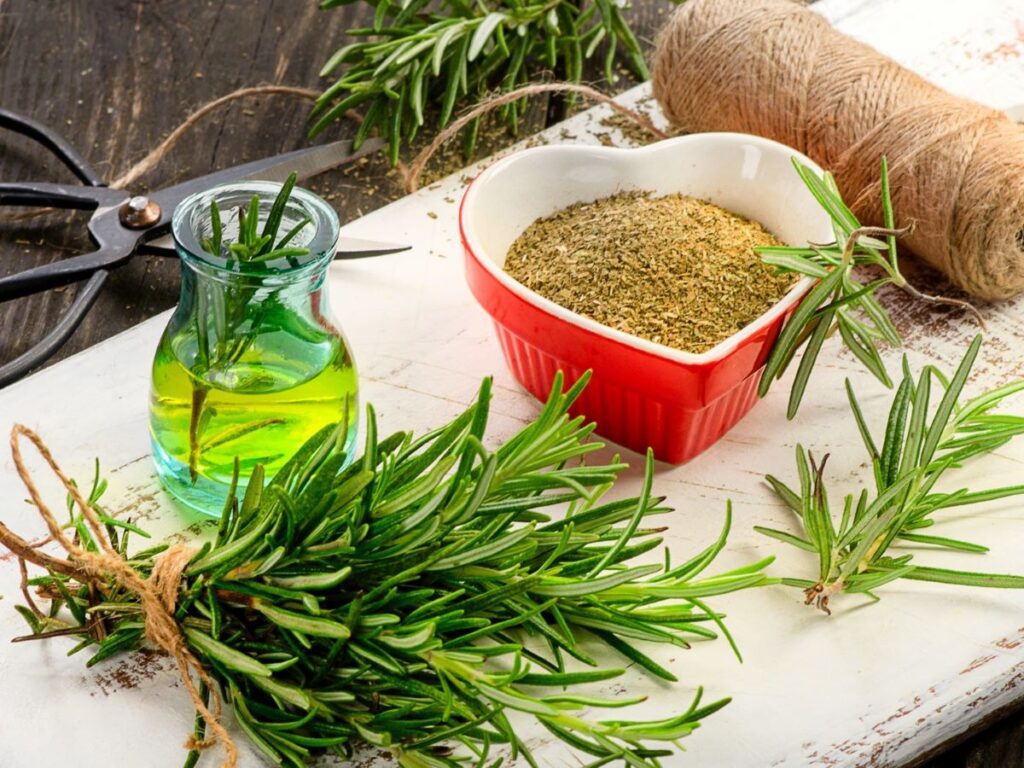
As you follow the guidelines shared in this article, you’ll soon realize that growing rosemary is not as challenging as it may seem. With just a little care and attention, you’ll be able to enjoy the beauty and delightful aroma of rosemary in your garden and the delicious taste of homegrown herbs in your kitchen.
Rosemary’s Benefits and Uses
Rosemary is not only a beautiful ornamental plant, but it also offers a variety of benefits and uses.
- It has a strong aroma that repels pests from other crops, protecting your garden and keeping it healthy.
- Rosemary has a long history in folklore and is believed to keep away witches and those with bad intentions. Simply hang a bundle of rosemary over your door or plant a few shrubs beside your house to promote a peaceful and protected environment.
- This lovely herb is also known for its stress-relieving properties and for instilling a sense of peace. Consider burning dried rosemary in your home to cleanse the space and remove negative energies. This ancient practice, known as smudging, will help create a more harmonious and tranquil atmosphere.
- Of course, let’s not forget the culinary uses of rosemary. Its distinct flavor and aroma enhance chicken, lamb, and fish dishes. Plus, rosemary can be infused into oils or used as a garnish to elevate the presentation of your meals.
By growing your own rosemary, you are creating an inviting environment that promotes well-being, protection, and culinary experimentation. Enjoy the process and reap the rewards of this versatile and delightful plant.
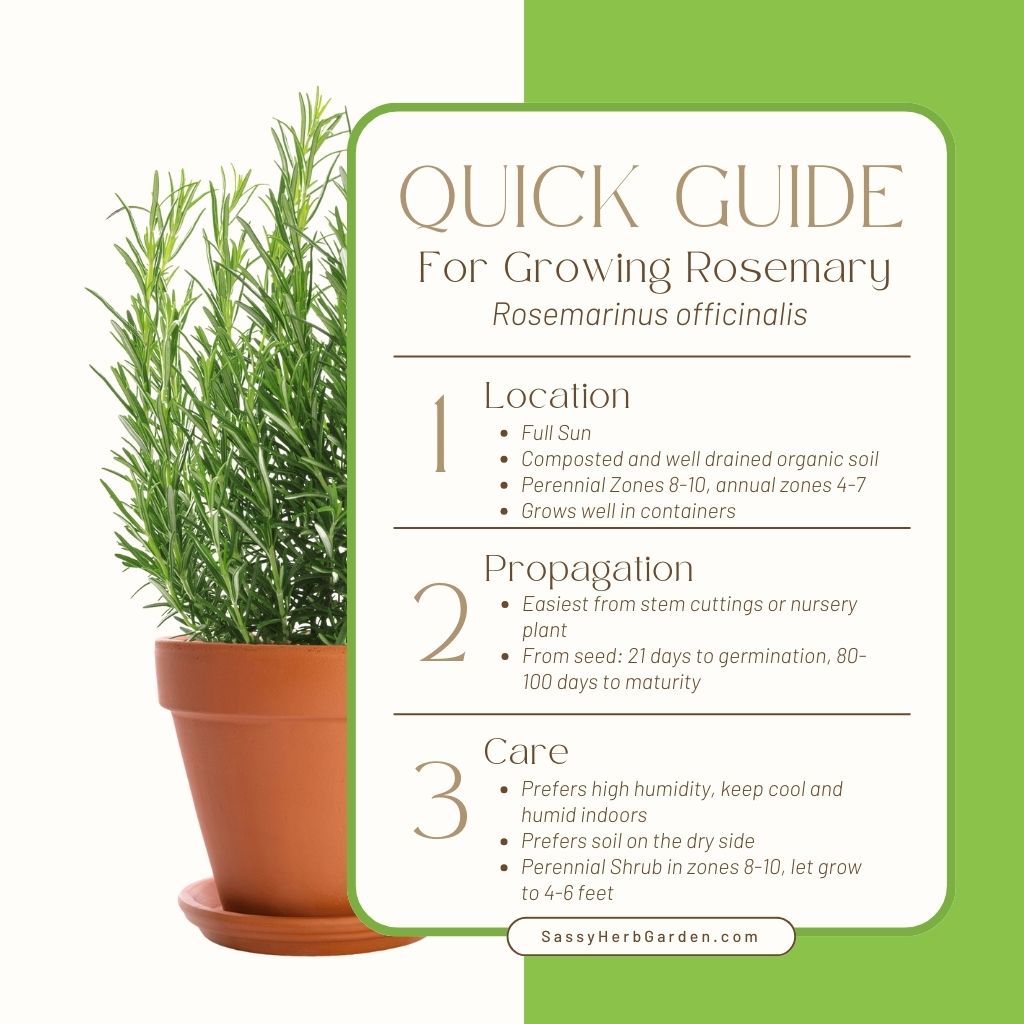
Why is Rosemary Often Called Difficult to Grow?
Rosemary is often listed as hard to grow. I’d say there are three reasons why growers consider it a difficult herb, and all are easy to overcome with a small amount of effort. Here are the top complaints:
Difficulty germinating seeds
Yes, it takes “forever” for rosemary seeds to germinate. Germination averages around 21 days and then it’s 100 days before the seedlings are ready to plant outside. That’s 4 months of babysitting those little plants and a lot can happen in that big window.
The biggest risks are around watering. Too much water before the roots are developed mold ensues. Miss a day of watering and the baby plants dry right up.
Solution: Start from cuttings or buy already established nursery plants. Easy, right? If you are determined to grow rosemary from seed then start your seeds and keep your seedlings where you see them every day. Not quite as easy, but you can do it!
Rosemary doesn’t like Northern winters
While rosemary is a perennial in zone 8 plus, it won’t overwinter outside in colder climates. For most herbs, you might treat your plant as an annual in this case, starting over each spring. The challenge with rosemary is that you get the best production from mature plants.
Solution: Grow Rosemary in a container that you can bring inside for the winter. If you don’t have room to grow herbs inside, then move the pot to a protected area, like your garage, where it is a little warmer than outside. Then insulate with straw.
The watering requirements are too complicated
This is the problem I battled during my first couple of efforts to grow rosemary. Both times the plant soil dried out and died instantly. I’m a busy gal and really like herbs that recover easily if I forget them for a few days. But I have a solution now, rosemary and I are once again friends.
The biggest reason this is a problem is because while rosemary may not like dry soil, it also doesn’t like wet feet. If the soil is heavy and holds a lot of water, or if you plant in a damp area root rot is just as likely to set in.
Solution: Add lots of organic matter in the soil. And I mean a lot! Organic matter does double duty of draining excess water away while holding moisture in the soil so rosemary doesn’t dry out completely. Organic matter works a lot like a sponge, with holes for drainage and cells that hold water. And for potted rosemary use a slightly larger pot than normal to ensure it doesn’t dry out completely on a hot sunny day.
Getting Started Growing Rosemary
Starting rosemary plants from cuttings is the easiest method, as opposed to growing from seeds. You can obtain a cutting from a friend’s plant or a community garden, ideally choosing a 4-inch piece to propagate. Once you have your cutting, it’s essential to provide the right growing conditions to ensure a thriving and healthy plant. You’ll need to pay attention to factors such as light, water, soil, climate, and temperature.
Growing from Cuttings: Step-by-Step
Rosemary can be propagated from cuttings fairly easily. Here’s your step-by-step guide.
- Select a healthy parent plant: Look for a rosemary plant with healthy, pest-free growth. This will increase your chances of successful propagation.
- Take a cutting: Clip off a 4-inch piece from the parent plant, making sure the cutting has several healthy leaves on it.
- Prepare the cutting: Remove the leaves from the lower 2 inches of the cutting, leaving the top 2 inches alone. This will prevent rot and encourage root growth.
- Plant the cutting: Dip the cut end of the cutting into a rooting hormone, and insert it into an organic potting mix. Keep it in a slightly acidic, moist, and well-drained environment.
- Provide support: Place a plastic bag or glass jar over the cutting to create a mini-greenhouse, ensuring adequate humidity for the cutting. However make sure you have ventilation and air movement to avoid mold growth.
- Monitor and care: Check the cutting regularly for root growth and keep the medium damp but not wet.
- Transplant when ready: Once the cuttings have developed a strong root system, transplant them into a larger pot or your garden.
Rosemary also does quite well in a hydroponic environment when started from cuttings.
Growing from Seed: Step by Step
Growing rosemary from seed requires patience. It takes 21 days for the seeds to germinate which is longer than most herbs. Additionally, seedlings are slow to grow. However, with a little extra attention you can start your rosemary garden from seed with these steps.
- Select seeds: Choose quality rosemary seeds for better germination rates. Purchase from a reputable supplier or save seeds from your own plants.
- Sow the seeds: Sprinkle the seeds on top of a moist organic seed starter mix, and lightly cover them with a thin layer of the soil mix.
- Provide optimal conditions: Place the seeds in a warm, well-lit area, and keep the soil moist during germination. This can take 2-4 weeks.
- Transplant seedlings: Once seedlings have developed 2-4 sets of true leaves, transplant them into individual pots or your garden. Choose a location with well-draining soil and full sunlight.
- Care for your plants: Water your rosemary plants regularly, but be careful not to overwater as they are susceptible to root rot.
Remember that rosemary will require repotting or transplanting as it outgrows its container or planting space.
Deciding Where to Plant Rosemary
Can you plant rosemary in your garden? Here’s a quick guide to help you decide.
- Rosemary is a perennial shrub when grown in zone 8 and warmer. It should be heavily mulched for winter.
- Gardeners in zones 6 and 7 often have success with keeping rosemary in the garden if it is in a well protected garden spot and heavily mulched for winter. If you want to try this, my advice is to take a couple cuttings to start indoors just in case your plant doesn’t survive.
- If you live in a cooler climate, I suggest you grow your rosemary in a container and bring it indoors during the colder months.
Garden Planting Site and Soil Conditions
When you’re choosing a garden location to plant your rosemary, it’s essential to consider the site and soil conditions. Rosemary plants thrive in well-drained soil with a pH between 6.0 and 7.0. To improve your chances of success, choose a spot with good drainage, and add a lot of organic matter to enrich the soil.
Sunlight and Temperature Requirements
Rosemary is a Mediterranean plant that needs plenty of sunlight. Aim to provide your rosemary plant with at least 6 hours of full sun daily. The more sun it receives, the better!
Preparing the Soil
Before planting your rosemary:
- Make sure the soil is well-draining. Don’t plant it in naturally wet areas of your garden.
- Test the pH of the soil using a home soil test kit to ensure it’s in the ideal range for rosemary (6.0-7.0).
- Rosemary benefits from adding a significant amount of organic matter to the soil to improve soil structure.
- Loosen the soil to a depth of 12 to 18 inches to allow the roots to easily establish themselves.
Finally, make sure to space your rosemary plants at least 2 to 3 feet apart to allow for proper air circulation and room for them to grow. With these planting tips, your rosemary will have an excellent start in your garden, and you’ll be able to enjoy this fragrant herb for years to come.
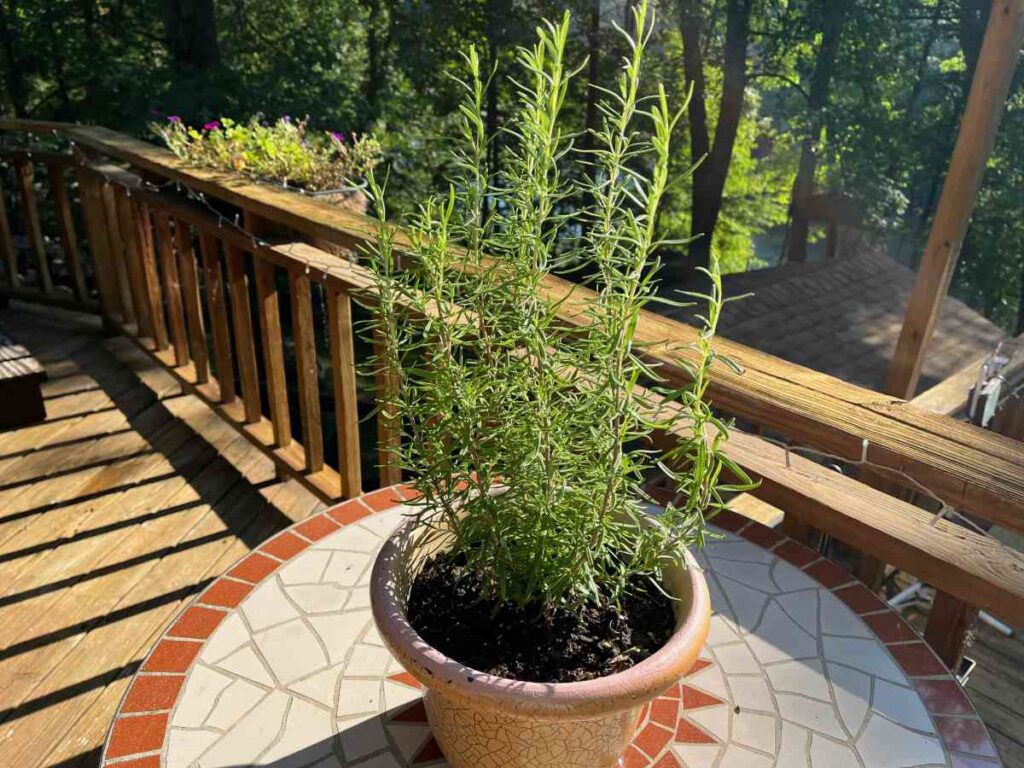
Growing Rosemary in Pots
Rosemary is the perfect herb for growing in pots. It does well in a bright kitchen window garden. And it thrives when planted in a large pot outside.
Rosemary Plant Care
Caring for your rosemary plant is a simple and rewarding process. In this section, we will cover the main aspects that you should pay attention to ensure optimal growth.
Watering
Consistent watering is crucial for your rosemary plant. These evergreen shrubs prefer well-drained soil and don’t like their roots to stay wet for long periods. Be sure to water your rosemary when the top inch of the soil feels dry to the touch. Over-watering can lead to root rot, so be cautious with your watering schedule. When growing rosemary in containers or pots, make sure they have drainage holes to prevent excess water from pooling.
Fertilizing
Rosemary plants typically don’t require much fertilizing. However, it’s a good idea to enrich the soil with some organic compost before planting. You can also use a slow-release fertilizer once or twice per year, following the instructions on the product label. Avoid over-fertilizing as it can cause your rosemary to grow rapidly, but lead to less robust and flavorful growth.
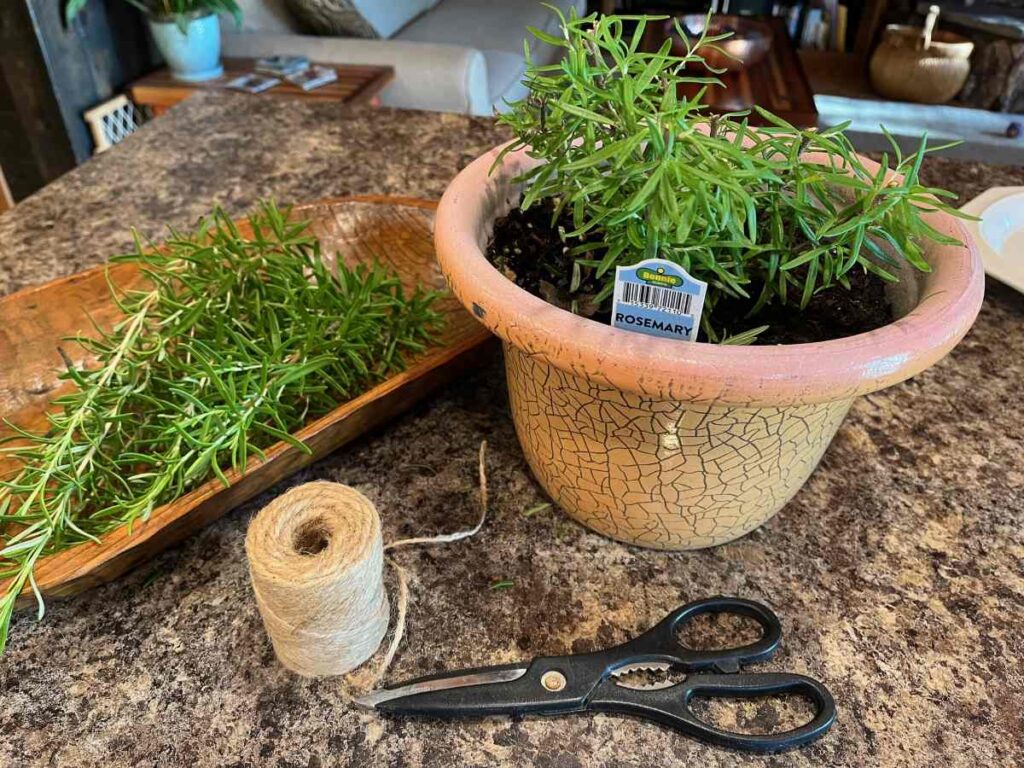
Pruning
Regular pruning is essential to maintain a neat and healthy rosemary shrub. Be sure to trim any overgrown or dead branches and remove any dead or yellowing leaves. Feel free to prune your rosemary bush as you need fresh herbs for your favorite recipes. To promote bushier growth, lightly pinch back new growth on the tips. Avoid cutting more than one-third of the plant at a time.
Harvesting
Harvesting your rosemary is a simple process that contributes to the overall care of your plant. You can start harvesting your rosemary as soon as it has sufficient new growth, usually about 4 to 6 inches. Use a clean, sharp pair of scissors or garden shears to cut the stems and leaves you need for your recipes. Be sure to harvest in moderation to avoid stressing the plant and allow for regrowth. Store your harvested rosemary in a cool, dry place, or preserve it by drying or freezing.
Common Problems and Solutions
Common Pests
With all of the challenges of growing rosemary, one thing you don’t have to worry about much is insect problems. It is a very pest tolerant plant.
Occasionally spider mites, aphids, or scale will appear on rosemary. Rosemary responds well to an organic soap-based insecticide.
Disease Management
One common disease affecting rosemary plants is root rot, which can be caused by overwatering or poor drainage. To prevent and manage root rot, you should:
- Ensure the soil has good drainage. If growing rosemary in a container, use a well-draining potting mix and a pot with drainage holes.
- Water your rosemary plant only when the top inch of soil is dry to the touch, typically weekly in the garden. The watering frequency for potted plants will vary with pot and plant size.
- Avoid letting the plant sit in standing water.
By addressing these common pests and diseases, you can keep your rosemary plant healthy and thriving.
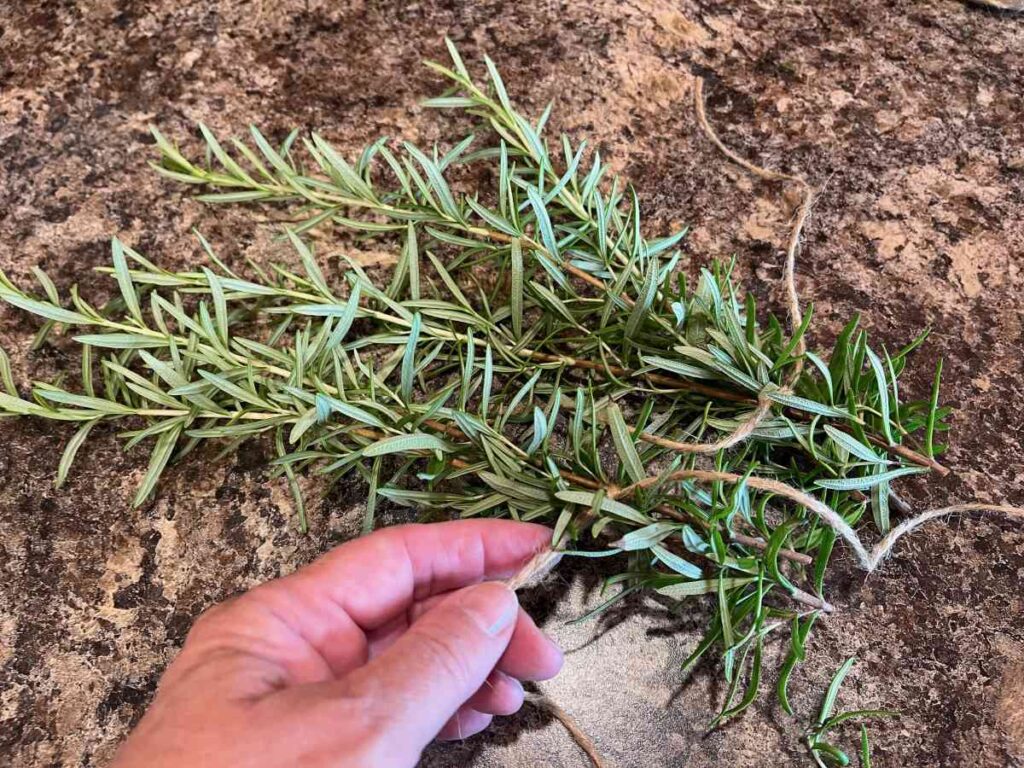
Preserving Your Rosemary
Drying
One of the best ways to preserve your rosemary is by drying it. To air dry the rosemary, hang single stems or small bundles in a warm, dry area out of direct sunlight1. Alternatively, you can dry the stems in a single layer in your food dehydrator set to the lowest setting, or 95°F1. This process may take up to 8-10 hours, depending on the ambient humidity.
Other Methods to Preserve Rosemary
Freezing: I love to freeze rosemary. Then it’s easy to use in recipes that call for fresh. You can either freeze whole sprigs or chop the leaves and store them in an airtight container or freezer bag. This way, you’ll have ready-to-use rosemary whenever you need it.
Fresh: If you prefer using fresh rosemary, you can keep it fresh for up to two weeks in the refrigerator. To store, wrap the stems in a damp paper towel and place them in a plastic bag before storing the bag in the refrigerator.
Storing
To store dried rosemary, place it in an airtight container to protect it from moisture and light. Store the container in a cool, dark place such as a pantry or cupboard. Dried rosemary will retain its flavor and aroma for at least six months to a year if stored properly.
By following these storage and preservation methods, you’ll always have rosemary at your disposal, whether you want to use it for cooking or enjoy its aromatic scent.
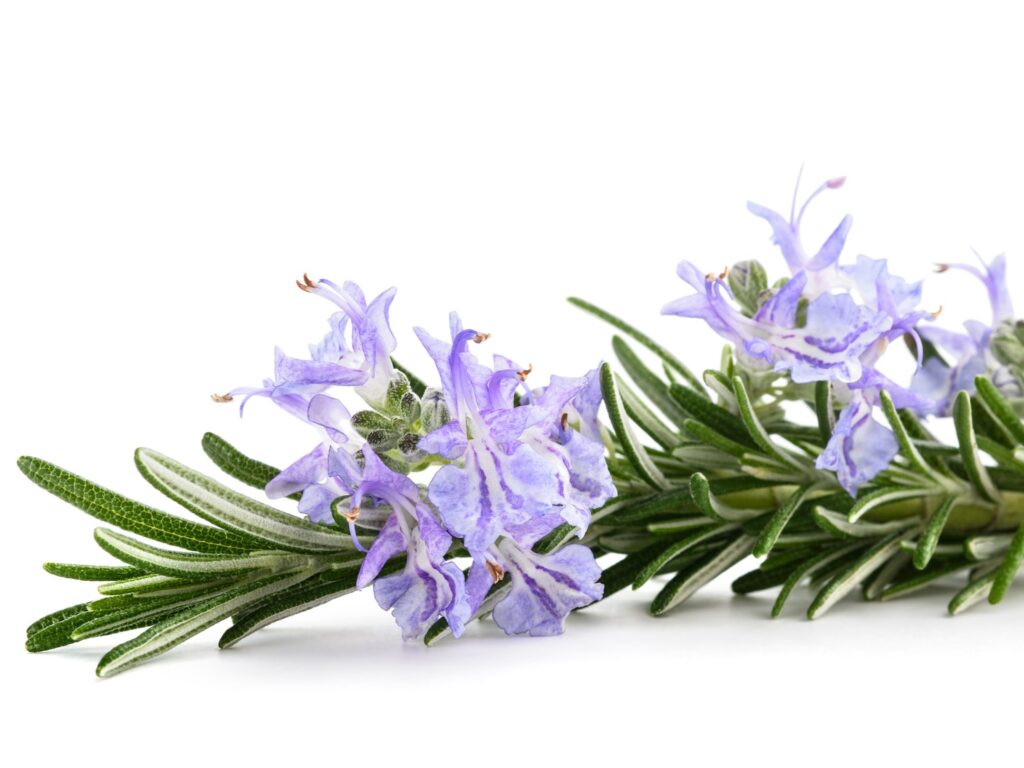
Using Rosemary in the Garden and Kitchen
Companion Planting
Rosemary’s aromatic needle-like leaves make it an excellent companion plant for your garden. It is known to help deter pests that are harmful to beans and cabbage.
In your herb garden plant rosemary alongside other herbs with similar care requirements like sage, thyme, lavender, oregano, and marjoram.
The beautiful blue flowers of rosemary make it perfect to plant alongside flowers like lavender, salvia, and sage. Here it can attract pollinators like bees and birds, promoting pollination in your garden.
Culinary Uses and Recipes
Rosemary (Rosmarinus officinalis) is a versatile culinary herb with a distinct fragrance, making it a popular addition to many dishes. Its needle-like leaves are used to flavor meats such as lamb, as well as vegetables and soups. Rosemary recipes that highlight the unique flavor are quite varied, ranging from beverages to chicken.
Aromatherapy
The fragrance of rosemary is not only enjoyed in the kitchen but also in the world of aromatherapy. Its essential oil is known for its ability to promote relaxation and improve mental clarity. You can add a few drops of rosemary essential oil to an oil diffuser or mix it with a carrier oil for massage.
Ornamental Uses
In addition to its culinary and aromatherapy uses, rosemary makes for an attractive ornamental plant in your garden. The prostratus variety, for example, produces delicate flowers that can be an excellent ground cover, attracting bees and other pollinators. The unique visual appeal and fragrance of rosemary make it a great addition to any garden or outdoor space.
Frequently Asked Questions
Is rosemary easy to grow?
Once rosemary is established it is easy to grow. All you need to do is provide well-drained soil, full sun, and occasional pruning to keep it healthy and flourishing. To start new plants requires extra effort and is moderately challenging.
What is the best environment for rosemary?
Rosemary thrives in a sunny location with well-draining soil. It prefers a slightly alkaline soil with a pH between 6.0 and 7.0. Make sure to give your rosemary plant plenty of space. You can also grow it in pots and keep it on a sunny windowsill for easy access when cooking.
Will rosemary regrow yearly?
Rosemary is a perennial evergreen shrub in warmer climates (zones 8 and up). In colder zones, consider growing rosemary in pots and bringing them indoors during the winter months to ensure their survival.
How long does it take rosemary to grow?
Rosemary is a relatively slow-growing herb. It may take up to a year for a new plant to reach a size suitable for regular harvesting. However, once established, rosemary will provide delicious aromatic leaves for your culinary needs for years to come.
A Few Last Thoughts about How to Grow Rosemary
Rosemary is one of those herbs that any gardening enthusiast or culinary aficionado will want in their garden. By understanding the specific needs of this aromatic herb—such as ample sunlight, well-draining soil, and moderate watering—you can ensure a healthy and bountiful growth.
With patience and care, your rosemary plants will thrive, providing you with a fresh supply of this versatile herb to enhance your cooking. Remember to prune regularly to encourage bushy growth and prevent woodiness. With the tips and insights provided in this guide on how to grow rosemary, you’re now well-equipped to start your own rosemary garden. I hope you enjoy the multitude of benefits that come with growing this timeless herb.

